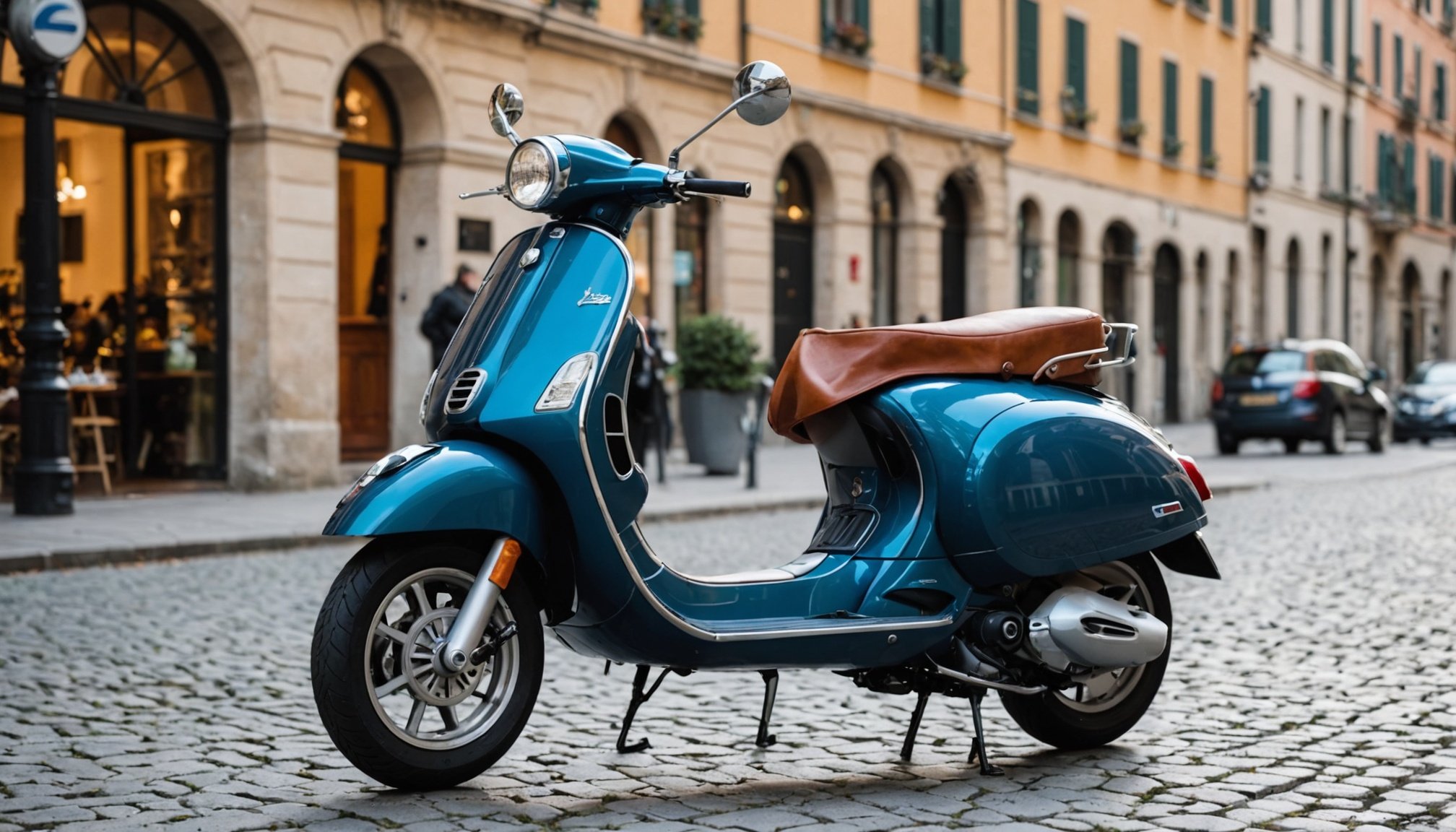Ultimate Winter Preparation: A Comprehensive Walkthrough for Safeguarding Your Vespa Primavera 150
As the winter months approach, it’s crucial to prepare your Vespa Primavera 150 for the cold and potentially harsh conditions. Whether you plan to continue riding or store your scooter, proper preparation is key to maintaining its performance and longevity. Here’s a detailed guide to help you safeguard your Vespa Primavera 150 this winter.
Understanding Your Vespa Primavera 150
Before diving into the preparation steps, it’s essential to understand the specifics of your Vespa Primavera 150. This scooter, part of the Vespa family, is known for its sleek design, robust engine, and versatile features.
Have you seen this : Mastering the art of yamaha fz-09 throttle body cleaning: proven techniques for optimal performance!
Key Specifications
- Engine: Single-cylinder, 4-stroke, 4 valves, electronic injection[1].
- Engine Capacity: 150 cc.
- Max Power: Around 10 kW (approximately 13.6 HP)[1].
- Fuel System: Electronic injection.
- Cooling: Liquid.
- Transmission: CVT with torque server.
- Brakes: Hydraulically operated discs both front and rear.
Understanding these specifications will help you tailor your winter preparation to the specific needs of your scooter.
Preparing Your Vespa for Winter Riding
If you plan to continue riding your Vespa Primavera 150 during the winter, here are some essential steps to ensure your safety and the scooter’s performance.
Also read : Ultimate diy guide: enhance your honda cb500x with a top case for superior storage options
Winter Accessories
To enhance your riding experience and safety, consider the following accessories:
- Heated Grips and Seat: These can be a game-changer for cold weather riding. The heated Comfort+ grips and seat, available for the Vespa GTS and potentially adaptable for the Primavera, can be adjusted via the heated accessory management module[1].
- Windshield: A windshield made from shock- and splinter-proof methacrylate can provide significant protection from wind and rain. It comes in high and medium versions for different levels of protection[1].
- Leg Cover: A leg cover made from thermal material can keep your legs warm and dry. It is easy to install and ensures riding comfort all year round[1].
Maintenance Checks
Regular maintenance is crucial, especially before the winter season.
- Tire Pressure: Ensure your tire pressure is at the recommended level. Proper pressure can improve traction on slippery roads.
- Brake Pads: Check the condition of your brake pads. Worn-out pads can be hazardous, especially on wet or icy roads.
- Oil and Fluids: Make sure your engine oil, brake fluid, and other essential fluids are at the recommended levels and are suitable for cold weather.
- Battery: Check your battery health. Cold weather can drain batteries faster, so ensure it is in good condition.
Riding Tips
- Slow Down: Reduce your speed to compensate for slippery roads.
- Use Proper Gear: Wear warm, waterproof gear including gloves, a helmet, and waterproof boots.
- Avoid Sudden Movements: Sudden acceleration, braking, or turning can be dangerous on icy or wet roads.
Winter Storage Preparation
If you decide to store your Vespa Primavera 150 for the winter, here are the steps to ensure it remains in good condition until the spring.
Cleaning and Protection
Before storing your scooter, give it a thorough cleaning.
- Wash and Dry: Wash your scooter to remove any dirt or grime. Dry it thoroughly to prevent rust.
- Wax and Protect: Apply a layer of wax to protect the paint and chrome parts from rust and corrosion.
- Powder Coated Frame: If you have a powder-coated frame, ensure it is free from any scratches or damage that could expose the metal to rust.
Storage Location
Choose a dry, secure location for storage.
- Indoor Storage: If possible, store your scooter in a garage or a dry, climate-controlled room.
- Cover Your Scooter: Use an outdoor vehicle cover to protect your scooter from dust and moisture if indoor storage is not available[1].
Fuel and Oil
Prepare your fuel and oil systems for storage.
- Fuel Stabilizer: Add a fuel stabilizer to the fuel tank to prevent fuel degradation over time.
- Drain or Fill: Either drain the fuel tank completely or fill it up to the top to minimize the space for moisture to accumulate.
- Oil Change: Change the engine oil before storage to ensure any contaminants are removed.
Battery Care
Proper battery care is essential during storage.
- Charge and Store: Charge your battery fully and store it in a cool, dry place away from metal objects.
- Battery Tender: Use a battery tender to keep the battery charged over the winter months.
Detailed Maintenance Tasks
Here are some detailed maintenance tasks to ensure your Vespa Primavera 150 is in top condition when you take it out of storage.
Engine Maintenance
- Spark Plug: Remove and clean the spark plug. If it’s old, consider replacing it.
- Air Filter: Clean or replace the air filter to ensure good engine performance.
- Crankcase Breather: Check the crankcase breather for any blockages and clean it if necessary.
Brake System
- Brake Fluid: Check the brake fluid level and top it off if necessary. Consider changing the brake fluid if it’s old.
- Brake Pads: Inspect the brake pads and replace them if they are worn out.
- Rear Brake: Make sure the rear brake is functioning properly. Adjust or replace it if necessary.
Suspension and Frame
- Front Suspension: Check the front suspension for any signs of wear or damage. Ensure the spring is in good condition.
- Rear Shock: Inspect the rear shock absorber and adjust the spring pre-load if necessary.
- Frame and Bearings: Check the frame for any signs of rust or damage. Ensure all bearings, including the wheel bearings, are in good condition.
Accessories and Customization
While preparing your Vespa for winter, you might also consider adding some accessories or customizations to enhance its functionality and style.
Luggage and Storage
- Top Box: A 36-liter top box, painted to match the bodywork of your scooter, can provide ample storage space. It comes with a padded backrest for passenger comfort[1].
- Leather Bag: A Vespa leather bag with reinforced panels can be a stylish alternative to the top box. It attaches to the rear luggage rack via a quick-release system[1].
Protective Components
- Perimeter Kit: A perimeter kit and front fender guard, crafted from steel tubing, can provide excellent protection for your scooter. These are available in chrome or black finishes[1].
- Fairing: A high-quality fairing in transparent or smoked version can add a sporty touch while providing some protection from the elements[1].
Practical Insights and Actionable Advice
Here are some practical tips and advice to keep in mind when preparing your Vespa Primavera 150 for winter:
Regular Checks
- Tire Pressure: Regularly check your tire pressure to ensure it remains at the recommended level.
- Battery Health: Monitor your battery health, especially during storage, to avoid any issues when you start riding again.
Storage Tips
- Center Stand: Use a center stand to elevate your scooter, making it easier to perform maintenance tasks and reducing the risk of flat spots on the tires.
- Washer Nut: Ensure the washer nut on the center stand is tightened properly to avoid any damage.
Riding Safety
- Right Hand, Left Hand: Always use your right hand to brake and your left hand to accelerate, especially on slippery roads.
- Make Sure, Ensure Your: Make sure your scooter is in good working condition before each ride. Ensure your gear is appropriate for the weather conditions.
Preparing your Vespa Primavera 150 for winter involves a combination of maintenance, storage, and accessory considerations. By following these steps, you can ensure your scooter remains in top condition, whether you choose to ride it through the winter or store it until the spring.
Key Takeaways
- Regular Maintenance: Regular maintenance checks are crucial for both riding and storage.
- Proper Storage: Choose a dry, secure location and use protective covers and accessories.
- Accessories: Consider adding winter-specific accessories to enhance your riding experience.
By taking the time to prepare your Vespa Primavera 150 for winter, you’ll be ready to hit the roads as soon as the weather improves, knowing your scooter is in the best possible condition.
Detailed Checklist for Winter Preparation
Here is a detailed checklist to help you prepare your Vespa Primavera 150 for winter:
For Riding
- Heated Grips and Seat: Install and test heated grips and seat.
- Windshield: Install a windshield for wind and rain protection.
- Leg Cover: Install a leg cover for warmth and comfort.
- Tire Pressure: Check and adjust tire pressure.
- Brake Pads: Inspect and replace brake pads if necessary.
- Oil and Fluids: Check and top off essential fluids.
- Battery: Check battery health and charge if necessary.
For Storage
- Cleaning and Protection: Clean and wax your scooter.
- Fuel Stabilizer: Add fuel stabilizer to the fuel tank.
- Drain or Fill Fuel Tank: Either drain the fuel tank or fill it up to the top.
- Oil Change: Change the engine oil.
- Battery Care: Charge and store the battery or use a battery tender.
- Center Stand: Use a center stand to elevate the scooter.
- Washer Nut: Ensure the washer nut is tightened properly.
General Maintenance
- Spark Plug: Remove, clean, and replace the spark plug if necessary.
- Air Filter: Clean or replace the air filter.
- Crankcase Breather: Check and clean the crankcase breather.
- Brake Fluid: Check and top off brake fluid.
- Brake Pads: Inspect and replace brake pads if necessary.
- Front Suspension: Check the front suspension for wear or damage.
- Rear Shock: Inspect and adjust the rear shock absorber.
- Frame and Bearings: Check the frame for rust or damage and ensure all bearings are in good condition.
By following this comprehensive guide, you’ll be well-prepared to safeguard your Vespa Primavera 150 through the winter months, ensuring it remains a reliable and stylish companion for years to come.








